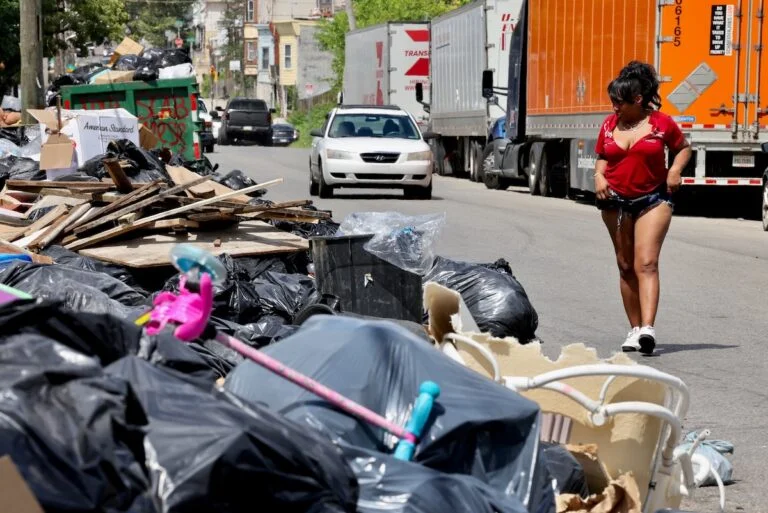Philadelphia’s recent sanitation strike broke from tradition with its tactics, timing, and community impact. Unlike past labor disputes, it involved grassroots organizing, social media advocacy, and public health concerns. Discover how this strike reshaped city negotiations and what it signals for the future of labor movements.

1. Introduction
In the summer of 2025, Philadelphia’s sanitation workers went on strike in what became one of the city’s most talked-about labor actions in recent years. While Philadelphia has a long history of union activism and labor disputes, this strike stood out for several key reasons — including its grassroots momentum, digital activism, and public health ramifications.
2. Historical Context: Labor Disputes in Philadelphia
Philadelphia is no stranger to labor unrest. From public transit strikes to teacher walkouts, the city has experienced numerous high-profile disputes:
- SEPTA strikes in the 2000s that crippled public transportation
- Teachers’ union protests over funding and charter school expansion
- Sanitation strikes in the 1970s and 1980s, focused largely on wages and job security
These past strikes were often driven by established unions and characterized by traditional picket lines and face-to-face negotiations with city leaders.
3. What Sparked the Sanitation Strike?
Unlike past disputes centered primarily on compensation, the 2025 sanitation strike was sparked by:
- Poor working conditions (e.g., outdated equipment, unsafe routes)
- Staffing shortages post-pandemic
- Lack of hazard pay during extreme heatwaves and environmental crises
- Delayed contract negotiations with the city’s Department of Streets
These issues were amplified by growing frustration over perceived neglect by city management.
4. Unique Features of the 2025 Sanitation Strike
Several key differences set this strike apart:
✦ Grassroots Leadership
While union leaders were involved, much of the early momentum came from rank-and-file workers using social media to organize, voice grievances, and mobilize support.
✦ No Formal Strike Vote Initially
Many workers began a “sick-out” — coordinated sick leave — before the union formally sanctioned a strike. This approach circumvented traditional channels and caught the city off guard.
✦ Broader Coalition Support
The strike gained backing from environmental groups, housing advocates, and public health organizations — highlighting the intersection between sanitation and community well-being.
5. Role of Social Media and Public Engagement
Unlike earlier disputes that relied on local media, the 2025 sanitation strike went viral. Workers shared behind-the-scenes videos showing:
- Broken trucks and unsafe working conditions
- Overflowing trash piles across neighborhoods
- Emotional testimonies about the impact on their families
The hashtag #PhillyDeservesCleanStreets trended for days, drawing national attention and increasing pressure on the city to respond swiftly.
6. Public Health and Safety Concerns
What made this strike particularly urgent was its immediate impact on public health:
- Garbage piled up during a record-breaking heatwave
- Increased risk of rodent infestations and disease
- Rising tension in lower-income neighborhoods disproportionately affected by the delays
Residents began organizing their own cleanup drives while also demanding accountability from city leaders.
7. Political Response and Negotiation Tactics
Philadelphia’s mayor and city council were forced into rapid response mode. Key differences in the city’s approach included:
- Public roundtables streamed online to improve transparency
- Emergency waste removal contracts with private vendors
- A short-term “cooling-off” period agreed upon to resume basic services while negotiations continued
This more open, tech-savvy approach to negotiation marked a shift from the more closed-door politics of past labor disputes.
8. Lessons and Implications for Future Labor Movements
The sanitation strike in Philadelphia may signal a new era of labor activism. Key takeaways include:
- Digital platforms amplify worker voices faster than traditional union channels
- Public health crises can shift public opinion in favor of striking workers
- Cross-sector alliances create a broader support network and bring new leverage to negotiations
This approach may influence how other public sector unions — in Philadelphia and beyond — plan future actions.
9. Conclusion
Philadelphia’s 2025 sanitation strike marked a turning point in how labor disputes are conducted and perceived. It wasn’t just about wages — it was about respect, safety, and dignity. With a fresh playbook and widespread community backing, sanitation workers challenged the system and redefined labor advocacy in the digital age.
